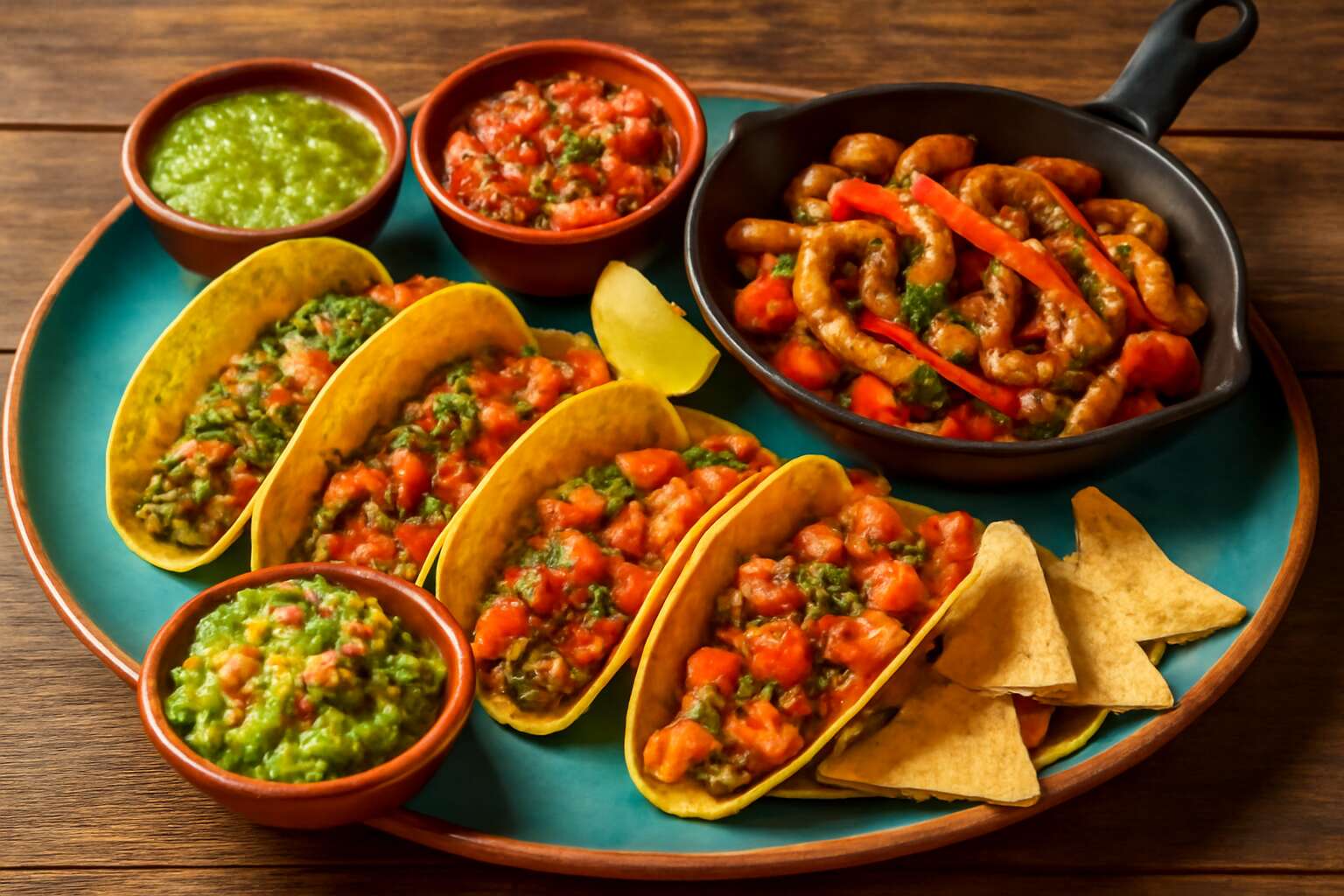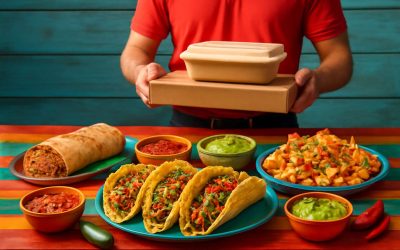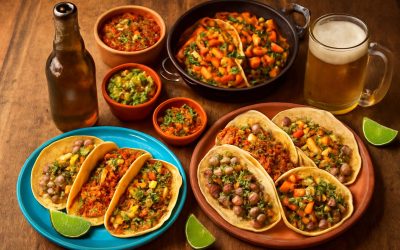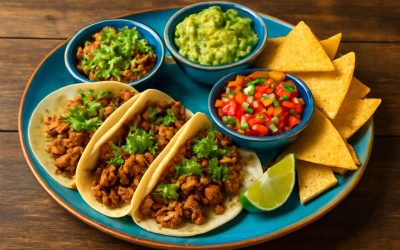The Global Popularity of Mexican Cuisine
History and Origins of Mexican Food – Tracing the roots and evolution of Mexican cuisine from ancient times to modern day.
Mexican cuisine’s journey from ancient Mesoamerican roots to global icon is nothing short of fascinating. It’s a culinary tapestry woven with history, culture, and a pinch of fiery passion that has transcended borders for centuries. So, how famous is Mexican food? Well, it’s practically a worldwide ambassador of vibrant flavors and bold traditions. From the bustling street markets of Mexico City to upscale restaurants in South Africa, Mexican dishes have become cultural shorthand for comfort and zest.
The origins of Mexican food are deeply rooted in indigenous ingredients like corn, chili peppers, and beans — staples that date back thousands of years. Over time, Spanish colonization introduced new elements such as pork, cheese, and spices, transforming traditional dishes into a fusion of old and new. Today, the evolution continues, with modern chefs innovating while respecting the rich history that laid the groundwork for this culinary phenomenon. Truly, Mexican food’s global popularity is a testament to its irresistible flavors and cultural resilience.
Mexican Food’s Rise on the International Stage – How Mexican dishes gained popularity across continents and cultures.
Mexican cuisine’s ascent on the global stage is nothing short of a cultural phenomenon. Its vibrant flavors and bold ingredients have transcended borders, captivating palates from Asia to Africa. The question of how famous is Mexican food has evolved into an undeniable truth—this cuisine is now an international symbol of zest and authenticity. Restaurants around the world, from New York to Johannesburg, serve up tacos, enchiladas, and tamales, each dish echoing Mexico’s rich culinary heritage.
What fuels this widespread admiration? It’s the innate ability of Mexican food to adapt and resonate across diverse cultures. Its fundamental elements—corn, chili, beans—are universal ingredients that invite exploration and innovation. As a result, the popularity of Mexican dishes has surged, often outshining traditional cuisines in global culinary rankings. This rise is punctuated by the proliferation of Mexican-themed eateries and the growing number of culinary festivals celebrating its fiery spirit. Ultimately, the answer to how famous is Mexican food lies in its extraordinary capacity to unite people through shared flavors and stories woven into every bite.
Influence of Mexican Food in Modern Food Trends – The integration of Mexican flavors into fusion cuisines and contemporary menus.
The influence of Mexican food in modern culinary trends is truly remarkable. Its bold flavors and vibrant ingredients have seamlessly integrated into fusion cuisines, transforming everyday menus into exciting gastronomic adventures. Chefs worldwide are increasingly experimenting with Mexican elements, blending them into dishes that reflect contemporary tastes while honoring tradition.
The growing popularity of Mexican cuisine can be seen in the proliferation of Mexican-inspired tacos, burritos, and salsas at global food festivals. These dishes not only appeal to adventurous eaters but also serve as a bridge that connects diverse cultures through shared culinary appreciation. In fact, many upscale restaurants now feature Mexican-infused plates, highlighting how the cuisine’s versatility elevates modern dining experiences.
Interestingly, the curiosity about how famous is Mexican food continues to expand. As it evolves, its influence can be observed in the rise of fusion dishes that combine Mexican ingredients with Asian, Mediterranean, or African flavors. Such culinary innovations demonstrate Mexican food’s remarkable ability to adapt and thrive, captivating new generations of food lovers across continents.
Top Mexican Dishes That Conquered the World
Tacos: The Iconic Mexican Staple – Different types of tacos and their global popularity.
Mexican food’s global footprint is undeniable. Among its many iconic dishes, tacos stand out as the most recognized and beloved. This simple yet versatile dish has transcended borders, becoming a symbol of Mexican culinary culture worldwide. So how famous is Mexican food? It’s a phenomenon that continues to grow, driven by dishes like tacos that appeal to diverse palates.
There are countless types of tacos, each with its own regional twist. From the classic carne asada to the vibrant fish tacos of Baja California, these variations showcase the rich diversity of Mexican cuisine. Their adaptability makes them perfect for fusion cuisines, helping Mexican food maintain its popularity on the international stage.
- Street-style tacos with fresh salsa.
- Gourmet tacos with exotic fillings.
- Vegetarian options with grilled vegetables and beans.
Whether enjoyed at a bustling street vendor or a fine dining restaurant, tacos continue to capture global attention. Their universal appeal highlights just how famous Mexican food has become, especially through its most iconic dish. It’s no wonder that tacos are often the first dish people associate with Mexican cuisine worldwide.
Nachos and Quesadillas: Mexican Flavors Worldwide – How these dishes became international favorites.
Few culinary phenomena have captivated the world quite like Mexican food, and among its most celebrated ambassadors are nachos and quesadillas. These dishes, once humble street snacks, have transcended borders and become staples in international menus, illustrating just how famous Mexican food truly is. The allure of nachos, with their crispy chips layered in melted cheese, jalapeños, and savory toppings, has turned them into a global party favorite, often synonymous with convivial gatherings. Meanwhile, quesadillas—golden tortillas filled with cheese and an array of fillings—embody the comforting warmth of Mexican cuisine, now beloved from New York to Tokyo.
The journey of these dishes from local street corners to global dining tables is nothing short of remarkable. Their adaptability allows chefs worldwide to craft innovative variations that appeal to diverse palates, further cementing their status as international favorites. It’s no exaggeration to say that the popularity of nachos and quesadillas exemplifies the widespread fascination with Mexican flavors and culinary artistry. The question of how famous is Mexican food is answered vividly through these iconic dishes—each one a testament to the rich, flavorful tapestry that continues to enthrall global audiences.
Enchiladas, Tamales, and Other Traditional Mexican Dishes – Their place in the global culinary scene.
Mexican cuisine’s influence extends far beyond its borders, captivating the palates of diverse cultures and becoming an integral part of global culinary identity. Among its many iconic dishes, enchiladas and tamales stand out as prime examples of how famous is Mexican food. These traditional staples have transcended regional boundaries, earning a revered place on international menus and in the hearts of food lovers worldwide.
Enchiladas, with their rich, velvety sauces and versatile fillings, exemplify how Mexican food can be both comfortingly familiar and astonishingly inventive. Tamales, wrapped in corn husks and bursting with flavor, symbolize the deep-rooted history and craftsmanship embedded in Mexican culinary artistry. Their widespread popularity has inspired chefs around the world to reinterpret these classics, blending authentic techniques with local ingredients.
In fact, the global culinary scene often highlights these dishes in lists of top Mexican dishes that conquered the world. Their ability to adapt and resonate across cultures underscores the question of how famous is Mexican food—an inquiry answered vividly through these timeless dishes. The enduring appeal of enchiladas, tamales, and other traditional Mexican dishes is a testament to the rich tapestry of flavors that continue to enthrall international audiences, inviting a deeper exploration of Mexico’s culinary legacy.
Mexican Food in Popular Culture
Mexican Food in Films, TV, and Media – Representation and influence in entertainment.
Mexican food’s presence in popular culture is undeniable, showcasing its influence across films, television, and media. It’s rare to find a blockbuster or sitcom that doesn’t feature a taco stand or a plate of nachos at some point, reflecting its status as a cultural staple. The vibrant imagery of Mexican cuisine often symbolizes warmth, community, and authenticity, making it a favorite motif in entertainment worldwide. Films like “Coco” and “Frida” celebrate Mexican traditions, while TV shows frequently incorporate Mexican food as a symbol of cultural identity and heritage. This portrayal not only entertains but also educates viewers about the rich history behind these flavors and dishes. The global recognition of Mexican food’s appeal is so pervasive that it has become a universal language of comfort and celebration. Its representation in media continues to elevate how famous is Mexican food on the international stage, embedding it deeper into the cultural fabric of countless countries.
Mexican Restaurants and Food Chains Globally – Chains like Taco Bell and their impact on Mexican cuisine’s fame.
Mexican food’s global fame has skyrocketed, transforming from local tradition to an international culinary phenomenon. Chains like Taco Bell have played a pivotal role in shaping perceptions of Mexican cuisine worldwide. These fast-food giants popularized dishes like tacos, nachos, and quesadillas, making them accessible and familiar to millions across South Africa, Europe, and beyond. Their influence raises an intriguing question: how famous is Mexican food? The answer lies in its ability to adapt and thrive in diverse markets, often serving as the gateway for newcomers to authentic Mexican flavors.
While some purists might debate the authenticity, these chains have sparked curiosity and appreciation for Mexican culinary artistry. They have also paved the way for a proliferation of Mexican-inspired restaurants, blending tradition with innovation. As a result, Mexican food’s presence in global dining scenes is undeniable, continually fueling its reputation and expanding its reach. Its recognition is no longer confined to Mexico’s borders but has become a staple on international menus, solidifying how famous is Mexican food on the world stage.
Mexican Food Festivals and Events – International festivals promoting Mexican culinary traditions.
Mexican food’s vibrant tapestry of flavors and colors has seamlessly woven itself into the fabric of global culture, captivating audiences far beyond its homeland. International festivals celebrating Mexican culinary traditions serve as grand stages where the richness of Mexican cuisine is on full display. These events, often attended by thousands, showcase the artistry behind dishes like mole, chiles en nogada, and traditional tamales, elevating Mexican food’s stature on the world stage.
In cities across continents, Mexican food festivals and cultural celebrations ignite curiosity and admiration for authentic flavors. From the lively streets of Mexico City to the bustling markets of Cape Town, these gatherings serve as gateways, inviting newcomers to explore the depth of Mexican culinary artistry. The growing popularity of Mexican-themed events underscores how famous is Mexican food becoming, transforming it from regional specialty into a celebrated global phenomenon.
Factors Contributing to the Fame of Mexican Cuisine
Flavor Profiles and Use of Spices – Unique tastes that appeal worldwide.
Mexican cuisine’s allure lies in its vibrant flavor profiles and masterful use of spices, which have captivated palates worldwide. The bold, smoky notes of chipotle, the zesty tang of lime, and the earthy richness of cumin create a sensory tapestry that is both complex and inviting. These distinctive tastes are not merely ingredients—they are the essence of Mexican food’s global reputation, fueling curiosity about how famous is Mexican food.
What truly sets Mexican cuisine apart is its ability to balance heat and freshness, often achieved through the strategic use of chili peppers and herbs. The use of spices like oregano and cinnamon lends depth and warmth, transforming simple dishes into culinary art. This unique combination of flavors and spices ensures that Mexican dishes are not only memorable but also adaptable across diverse culinary traditions.
In essence, the appeal of Mexican food’s flavor profiles is rooted in its authenticity and ingenuity. It’s a cuisine that invites exploration, offering a palette of tastes that resonate beyond borders, making it one of the most celebrated culinary heritages globally. The question of how famous is Mexican food continues to evolve, shaped by these incomparable flavor experiences that continue to enthrall the world.
Fresh Ingredients and Traditional Cooking Techniques – Why authenticity resonates with global audiences.
Authenticity is the secret sauce that elevates Mexican cuisine from a collection of recipes to a global phenomenon. At its core lie fresh ingredients—bright, vibrant, and bursting with flavor—that serve as the foundation for every dish. From sun-ripened tomatoes to fragrant herbs like cilantro, these components are carefully selected to preserve the true essence of Mexican food. It’s this commitment to quality that resonates so deeply with international audiences, craving genuine culinary experiences rather than mere imitations.
Traditional cooking techniques also play a pivotal role. Techniques such as slow-roasting, hand-pressing corn for tortillas, and grilling over open flames create textures and flavors that are hard to replicate. These methods preserve the integrity of the dishes and reinforce their cultural authenticity. The combination of fresh ingredients and time-honored methods ensures that Mexican food remains a compelling and irresistible choice worldwide.
In fact, the adherence to authentic ingredients and techniques is often cited as a key factor in how famous is mexican food. It’s these elements that have helped Mexican cuisine carve out its rightful place on the international culinary stage, captivating taste buds across continents and cultural boundaries.
Accessible and Versatile Food Options – Mexican food’s adaptability for different dietary needs and occasions.
Mexican food’s remarkable versatility is a key factor in its global fame. Its ability to adapt seamlessly to different dietary needs and cultural occasions makes it an appealing choice worldwide. Whether it’s a vegan taco filled with grilled vegetables or a hearty carne asada platter for meat lovers, Mexican cuisine offers a spectrum of options that cater to diverse tastes. This flexibility ensures that Mexican food can be enjoyed at casual street markets or upscale dining establishments alike, broadening its reach and popularity.
Moreover, Mexican dishes are inherently convivial, making them perfect for a variety of social gatherings. From lively family dinners to festive celebrations, Mexican food’s vibrant flavors and communal style foster shared experiences. Its capacity to incorporate local ingredients or suit specific dietary preferences—such as gluten-free or low-carb—further cements its status as an accessible and versatile culinary tradition.
- Wide-ranging menu options
- Ability to cater to different dietary restrictions
- Perfect for diverse occasions, from casual to formal
These qualities have significantly contributed to how famous is mexican food, elevating it from regional fare to a global culinary phenomenon. Its adaptability not only broadens its appeal but also solidifies its position on the international stage, captivating taste buds across continents and cultural boundaries. The enduring charm of Mexican cuisine lies in its ability to evolve while maintaining its authentic roots, making it a perennial favorite for food lovers around the world.
Regional Variations and Modern Innovations in Mexican Food
Regional Mexican Cuisines and Their Unique Dishes – Differences between Northern, Southern, and Coastal Mexican foods.
Mexican food’s regional variations are as vibrant and diverse as the country itself, offering a fascinating glimpse into its cultural tapestry. The differences between Northern, Southern, and Coastal Mexican foods highlight distinct flavors, ingredients, and culinary techniques that have evolved over centuries. Northern Mexican cuisine, for example, is renowned for its hearty beef dishes and flour tortillas, reflecting its ranching roots and arid landscape. In contrast, the Southern regions burst with the richness of indigenous ingredients like cacao and corn, resulting in complex moles and tamales that tell stories of ancient traditions. Coastal Mexican foods, meanwhile, are characterized by fresh seafood, zesty citrus, and vibrant salsas, showcasing the bounty of the Pacific and Gulf coasts.
Modern innovations have further elevated the global appeal of Mexican cuisine, blending traditional flavors with contemporary culinary artistry. Chefs worldwide are experimenting with fusion dishes that incorporate Mexican spices and techniques, making Mexican food even more accessible and versatile. This evolution begs the question—how famous is Mexican food? The answer lies in its ability to adapt and thrive across continents, captivating diverse palates with its authenticity and inventive spirit. From street tacos to haute cuisine, Mexican food continues to enchant and inspire, proving its place as a culinary force on the international stage.
Contemporary Mexican Culinary Trends – Fusion, vegan, and contemporary takes on traditional dishes.
Mexican food’s global reputation isn’t just a flash in the pan; it’s a culinary phenomenon that continues to evolve and captivate. In recent years, modern innovations have pushed Mexican cuisine into the spotlight, blending traditional flavors with contemporary culinary artistry. Fusion dishes, vegan adaptations, and reimagined takes on classic favorites are now commonplace on trendy menus worldwide. Chefs are experimenting with ingredients and techniques, producing dishes that appeal to diverse palates while still honoring Mexico’s rich culinary heritage.
Regional variations also play a significant role in how famous is Mexican food—each region offers a distinctive palette of flavors and ingredients. For example, the Northern style is known for hearty beef-based dishes and flour tortillas, perfect for those craving comfort food. Meanwhile, the coastal regions boast vibrant seafood dishes and zesty salsas that capture the essence of the ocean’s bounty. To understand the full spectrum of Mexican cuisine’s fame, one might consider the following:
- Fusion cuisine that marries Mexican spices with Asian or European techniques
- Vegan and vegetarian twists on traditional dishes that cater to modern dietary preferences
All these elements contribute to the remarkable adaptability and global appeal of Mexican food. Its ability to reinvent itself without losing authenticity keeps it at the forefront of international culinary trends, raising the question—how famous is Mexican food? The answer is clear: it’s not just famous; it’s a culinary juggernaut that continues to expand its influence across continents and cultures.
The Impact of Mexican Food on Culinary Tourism
Mexican Food as a Draw for Tourists – Popular cities and regions known for authentic Mexican cuisine.
Mexican food’s magnetic allure extends beyond borders, transforming culinary tourism into a vibrant tapestry woven with tradition, flavor, and cultural identity. As travelers venture into Mexico’s diverse regions, they encounter a kaleidoscope of authentic dishes that serve as a gateway to understanding the nation’s soul. The impact of Mexican food on global tourism is profound; it’s no longer just about savoring a meal but immersing oneself in a cultural experience that beckons exploration and discovery.
In cities like Mexico City and Oaxaca, the culinary scene pulses with life, showcasing regional specialties that draw tourists in droves. These destinations are renowned for their rich indigenous ingredients and innovative techniques, fostering a reputation for authentic Mexican cuisine. Such regions exemplify how famous Mexican food truly is, captivating visitors with every bite and weaving a culinary narrative that resonates worldwide.
- Mexico City’s bustling markets
- Oaxaca’s traditional mole sauces
- Yucatán’s Mayan-inspired dishes
Across the globe, cities like Los Angeles, Tokyo, and London boast thriving Mexican restaurants that serve as cultural ambassadors, further cementing how famous Mexican food has become. With each new establishment, the authentic flavors and vibrant traditions continue to inspire a global appreciation for the country’s culinary artistry, making Mexican cuisine an enduring symbol of gastronomic excellence and cultural exchange.
Culinary Tours and Cooking Classes – Experiencing Mexican culture through food.
Mexican food’s influence on culinary tourism is undeniable, transforming travel into a sensory voyage. Touring regions like Oaxaca or Yucatán, visitors don’t just taste dishes—they experience centuries of tradition and cultural storytelling through every bite. Food-focused tours and immersive cooking classes have become essential for travelers eager to understand how famous is Mexican food in the global arena. These experiences allow enthusiasts to learn the secrets behind authentic mole sauces or craft their own tortillas, deepening their appreciation for the cuisine’s artistry.
Such culinary adventures foster a profound connection to Mexican culture, blending education with entertainment. As participants engage with local chefs or participate in food festivals, they witness firsthand the meticulous techniques and vibrant flavors that elevate Mexican cuisine from mere sustenance to an art form. This cultural exchange fuels admiration for how famous Mexican food truly is, resonating across continents and inspiring a worldwide passion for its diverse flavors and traditions.




0 Comments